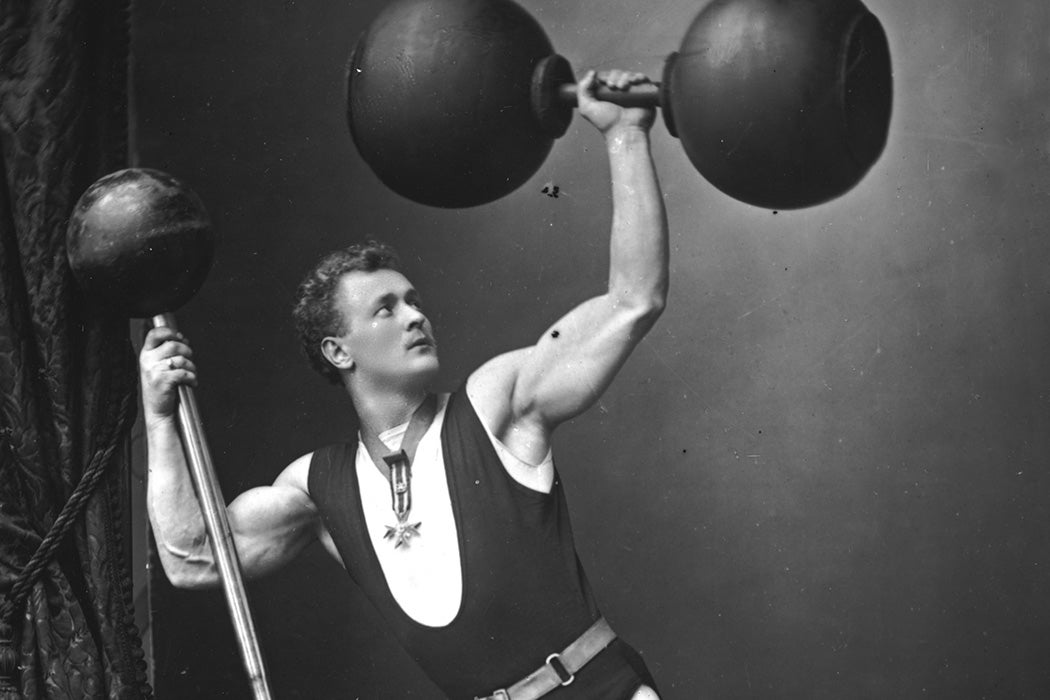In 1893, Prussian strongman Eugen Sandow began staging performances, complete with tableaux vivants, in respectable theaters in the United States. This tour took him a long way from his carnival sideshow origins. Before an audience of elites, he posed as Hercules, Achilles, the Fighting Gladiator, the Dying Gaul, and other exemplars of masculine strength taken from ancient Greece and Rome. Photographs of his fig-leaf-clad body were all the rage, even sidestepping post-office censorship thanks to their allusions to Classical Antiquity.
Sandow-mania set the template for bodybuilder celebrities to come. He became the “consummate incarnation of classical form no less than an ideal model of contemporary physical manhood,” writes religious studies scholar Rachel McBride Lindsey. But this “sickly Prussian boy [who] became an icon of muscled American masculinity”—had some competition from another foreign-born icon. “Contending for the title of the most ubiquitous model of moral and physical manhood among white Protestant American men was Jesus,” writes Lindsey. “The contours of manhood coded in Sandow’s sinew were rendered in contemporary depictions of Jesus as the model physical type.”
A muscled-up Jesus was the most visual marker of Muscular Christianity. This theological/philosophical movement originated in Britain and was taken up in the US in the late nineteenth century by evangelical Protestants. The movement stressed self-sacrifice, patriotism, masculinity, physical culture, and sports. Especially team sports. Epitomized by the YMCA and ballyhooed in the cult of the outdoors personified by Teddy Roosevelt, the new gospel of health and virility was a reaction against the perceived emasculation of white American men. Anglo-Saxons were said to be growing flabby in office jobs; being replaced in blue color jobs by non-white immigrants; and suffering, as always, under the yoke of emancipated women.

Both the “Teutonic” Sandow, contemporaneously called the “modern Hercules,” and Jesus, the “supremely manly man,” according to one of Muscular Christianity’s main American publicists, set a new definition for the “perfect” American man. They mirrored each other.
Sandow pumped iron and sold his book Strength and How To Obtain It (1897; still in print), but the transformation of a supposedly first-century Jewish Galilean into a nineteenth-century Anglo Saxon Protestant fantasy was close to miraculous. Centuries of Christian iconography had portrayed Jesus with long flowing hair, a meek continence, and a look of passivity and resignation to his fate. Muscular Christians condemned all this as effeminate. They butched-up Jesus, wrapping him in muscle and making him a blond Aryan.
This was the same period that saw the rise of anthropometry, the measurement of man, to determine “male somatic perfection” and racial hierarchy. Students at elite colleges were measured—in more than fifty different ways at Harvard, for instance— as “the old project of abstract human proportion” was “recalibrated to a system of racialized difference though specialized instrumentation.” Skulls of all the “races” were measured, typologies and categories set, with the prize of whiteness above all defined as Protestant and Nordic/Teutonic/Anglo-Saxon. (Stephen Jay Gould’s 1981 The Mismeasure of Man details how nonsensical and actively fraudulent this “science” actually was.)
Weekly Newsletter
All this set the scene for eugenics, including state-mandated sterilization, and the closing of the immigration door in 1924. A dozen years before the gates were closed, a “scrawny weakling” of a pre-teen named Angelo Siciliano came to Brooklyn, New York, with his Calabrian family. In 1922, Siciliano changed his name to Charles Atlas, under which he inherited Sandow’s mantle and found fame and fortune as the seller of a body-building scheme to skinny kids on the beach everywhere. Italians, after all, were eventually welcomed into whiteness.
The Sandow/Jesus moment, Lindsay concludes, was one of “heightened national anxiety on the heels of rapid demographic, intellectual, and political transformation.” Not unlike today, when portrayals of Jesus as a Rambo-like figure, sometimes even complete with AR-15, and the seventy-six-year-old Donald Trump as a buff, thirty-something Jesus-like figure, can be found among the iconography of the Right.







